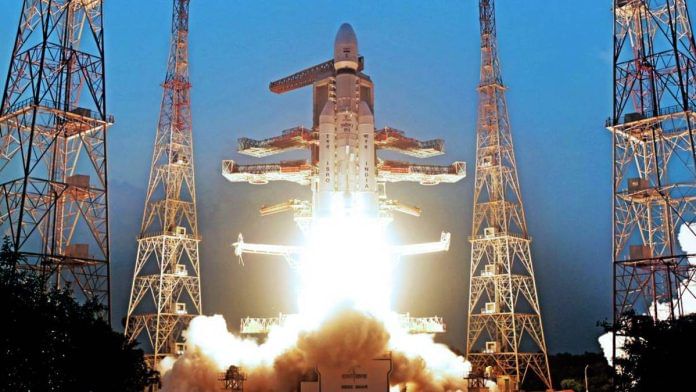New Delhi: The Indian Space Research Organisation’s (ISRO) latest mission, which launched India’s heaviest military communications satellite, is expected to be a major leap in ushering a new age of maritime domain awareness.
On Sunday, ISRO’s LMV3 rocket set off the CMS-03 communication satellite from Sriharikota spaceport.
“ISRO has successfully launched the heaviest GEO (geostationary orbit) communication satellite from Indian soil. The Indian space sector is soaring high to provide valuable services to the user community in and around the Indian region,” ISRO chairperson V. Narayanan said in a statement after the launch.
ThePrint explains the significance of the mission and how the satellite will help India’s space-domain communication, especially in the military domain.
The mission
The CMS-03 is a 4,410-kg satellite that will primarily serve the Indian Navy. According to ISRO, it is a multi-band communication satellite that will provide services over a wide oceanic region, including the Indian landmasses.
“This is the heaviest communication satellite to be launched to Geosynchronous Transfer Orbit from Indian soil,” read the space agency’s mission brochure.
The LVM3 had last launched the Chandrayaan-3 mission in 2023, making India the first country to land near the lunar south pole.
The Indian space agency has launched heavier satellites in the past, like the GSAT-11 in 2018, which weighed over 5,800 kg. But it was launched on the European launch vehicle Ariane-5. All satellites weighing over 3,000 kg had to be outsourced because of the weight limitations of Indian launch vehicles.
Earlier referred to as Geosynchronous Launch Vehicle Mk-3 (GSLV Mk-3), LVM3 is a multipurpose launch vehicle which uses solid, liquid and cryogenic fuel-based engines. It is capable of placing satellites weighing up to 8,000 kg in low Earth orbit (LEO)—an altitude of about 2,000 km from Earth—and up to 4,000 kg in GEO—an altitude of about 36,000 km.
Initially, the rocket was limited to missions that required launching satellites to more distant orbits. However, in 2022, the LVM3 was modified.
Strategic use
CMS-03 is the most advanced communication satellite launched for the Indian Navy. It is a replacement for 2013 GSAT-7, which was launched on board Ariane-5.
“GSAT-7R (another name for CMS-03) will provide robust telecommunication coverage across the Indian Ocean Region,” the Ministry of Defence said in a statement.
CMS-03’s payloads include a transponder, capable of supporting voice, data and video links over multiple communication bands. It also promises to significantly enhance connectivity with high-capacity bandwidth, enabling seamless and secure communication links between ships, aircraft, submarines and maritime operations centres of the Indian Navy.
The satellite will have a life of at least 15 years.
The launch is believed to be a major step towards making India self-reliant in military communications.
“Due to recent geopolitical developments in the space domain, having an autonomous presence in orbit becomes essential. The CMS-03 is more than an upgrade to India’s defence communications fleet; it’s a structural reinforcement of our national space infrastructure,” said Yashas Karanam, co-founder of the Indian space start-up, Bellatrix Aerospace.
He added that the mission marks India’s readiness for a future where secure, sovereign space connectivity becomes the foundation of strategic autonomy.
“Each such mission pushes the boundaries of capability and confidence, paving the way for a self-reliant ecosystem that thrives on innovation across every layer, from launch to payload to propulsion,” he told ThePrint.
(Edited by Nida Fatima Siddiqui)
Also Read: A Bengaluru startup is making space travel greener; co-founder says ‘fuel of the future’ is here






